How to Create A Mental Health App in 2024 – A Complete Guide

Dealing with psychological challenges has always been an aspect of human existence. The Covid-19 pandemic with its strict quarantine measures made the situation almost critical. Due to the pandemic, the number of anxiety and depressive disorders grew. According to THIS data, Depressive symptoms grew from a base of about 193 million people worldwide to 246 million. Anxiety disorders grew from about 298 million people affected to 374 million. People all over the world required emotional support during periods of self isolation. That’s when the demand for effective mental health apps started to rise. Furthermore, the tendency is not changing. People keep benefiting from apps’ on-the-go tools, convenience and efficiency. For many users nowadays, there is no point in coming back to old approaches. Now, the market offers a plethora of solutions catering to various psychological issues from OCD to anxiety.
However, many existing solutions offer services that are subpar or average in quality. Plus, there are challenges related to privacy concerns and the effectiveness of methodologies. In app stores, visitors keep leaving negative reviews, complaining about:
- issues with sustaining interest over time
- lack of helpful evidence-based approaches
- difficulties in integrating new habits into daily routines etc.
Thus, there is still a great potential for mental health app developers. By identifying and addressing such drawbacks, a new app can carve out a niche and provide unique value to those seeking effective and engaging psychological support. So, if you consider creating a mental health app, this article is for you. Let’s delve into mental health app development aspects and review its best practices!
Why Is a mental health app necessary?
Every person on our planet deals with factors that lead to stress and anxiety on a daily basis. Numbers also speak for themselves:
- in 2021, 21 million adults reported having at least one episode of major depression;
- the impact depression has on the global economy is measured in $1 trillion in lost productivity each year;
- 19.1 million adults in the U.S. ages 19 to 54 experience an anxiety disorder. Plus, more than 3 million men experience panic disorder, agoraphobia or other phobias;
- more than 1 in 7 UK adults say their mental health is currently either bad, or the worst it’s ever been.
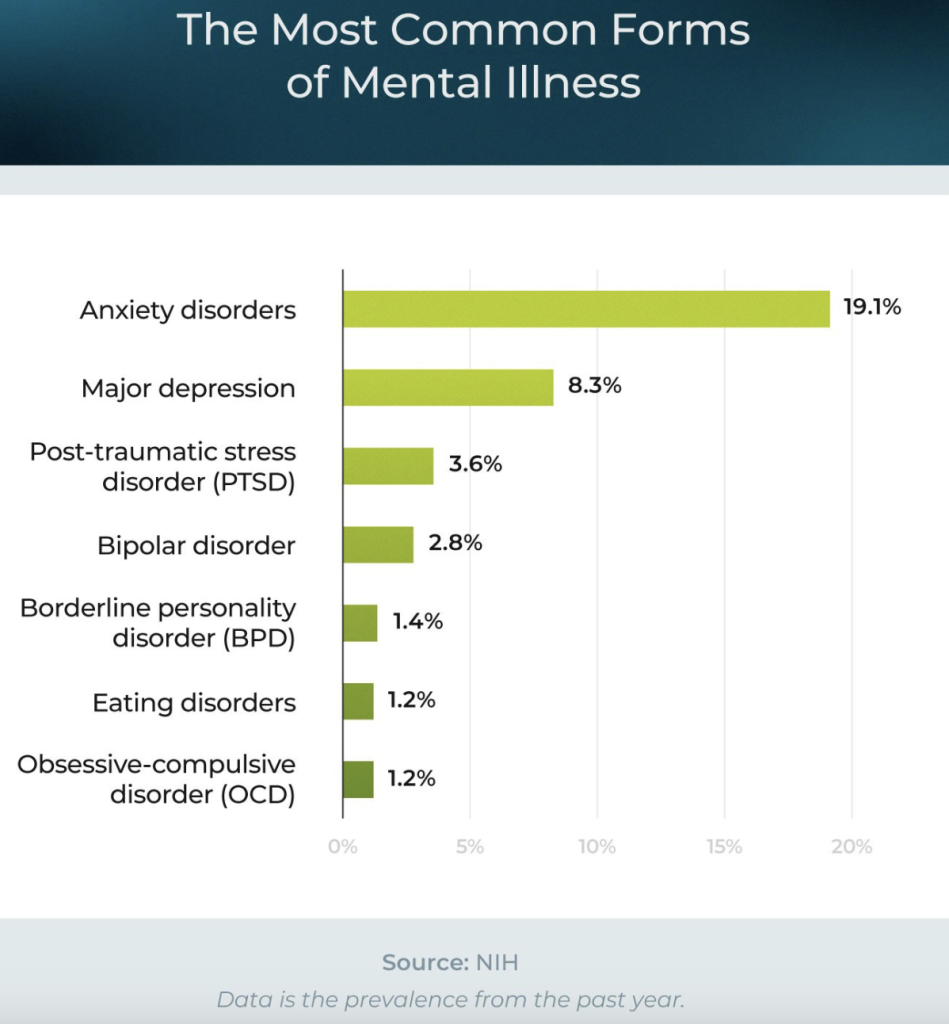
Unfortunately, lots of people do not receive necessary help. According to THIS survey , one-third of respondents could not get the mental health services they needed. When asked about the specific barriers to accessing care, 80% cited cost and more than 60% cited shame and stigma as the main obstacles. That is why mental health apps become a solution in these cases. Almost anyone can receive help without the need to physically visit facilities or therapy sessions. Individuals can finally learn strategies for managing emotional challenges they constantly encounter. Plus, they can maintain emotional stability and connect with healthcare professionals when necessary. Let’s talk about all these benefits in detail.
Benefits of a mental health app
Mental health apps play a crucial role in promoting mental well-being. Such solutions offer accessible, personalized, and confidential support to anyone with a smartphone. Thus, main benefits include:
Accessibility and Convenience
Users access support anytime, anywhere, eliminating barriers such as travel time/scheduling conflicts. This round-the-clock availability ensures individuals receive help when they need it most.
Personalization and Tailored Support
Through self-assessment quizzes, mood tracking features, and goal-setting functionalities, individuals receive help that:
- addresses their specific, personal concerns
- promotes a sense of empowerment in their recovery journey.
Anonymity and Privacy
Seeking psychological help may be daunting due to concerns about stigma or privacy. Mobile applications offer a level of anonymity traditional face-to-face interactions do not provide. It means apps finally allow people to seek support fully confidentially. This level of privacy encourages them to be more candid about their emotions. Thus, it facilitates a more open and honest therapeutic process.
Progress Tracking
By consistently monitoring mood fluctuations, medication adherence, sleep patterns, and other relevant metrics, users can track progress towards their goals. Such regular monitoring lets them identify triggers, patterns, and areas for improvement.
Types of Mental Health Apps
Mental health app development mainly focuses on providing assistance to those dealing with common psychological issues, as well as helping prevent depression, fostering motivation and promoting a healthy routine. Typically, such solutions are categorized based on the approach/methodology used or specific challenges/problems to solve. Some of them combine several options in one to cater to a wider target audience. For instance, when daily relaxation techniques are combined with anti-anxiety ones etc. Here are the main app categories present on the market:
Anxiety and Stress Management
These apps focus on providing tools and techniques to reduce feelings of anxiety. To promote calmness and emotional regulation, such solutions often feature:
- guided breathing exercises
- mindfulness practices
- relaxation techniques
- cognitive behavioral therapy (CBT) exercises
For example, Sanvello is a popular stress reduction instrument. It offers a meditation library, guided journeys, cognitive tools for coping with stress.
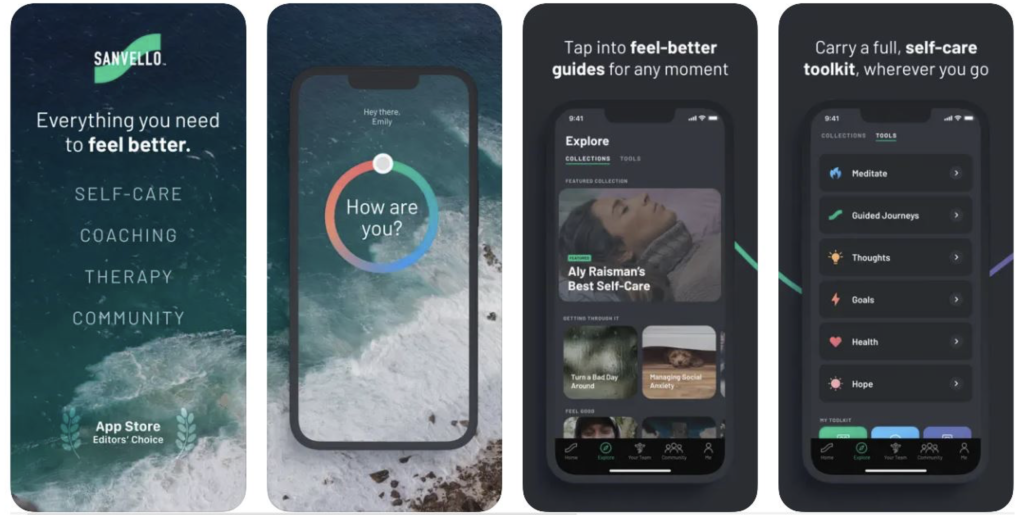
Mood Tracking and Journaling
These applications let users monitor their daily emotional states. Thus, they can identify patterns in mood fluctuations and gain insights into their mental well-being.
For instance, Daylio stands out for its combination of mood tracking features with the ability to add notes akin to journal entries. It offers the flexibility to document emotions while also providing prompts for journaling.

Depression and Mood Disorder
Such apps offer support and coping strategies for those struggling with depressive symptoms. The typical functionality may include:
- mood-boosting activities
- self-care tips
- goal-setting features
- access to healthcare professionals for guidance and intervention.
MoodKit was developed by clinical psychologists and grounded in Cognitive Behavioral Therapy principles. It provides a wide array of over 200 evidence-based activities aimed at helping people identify and manage their symptoms.
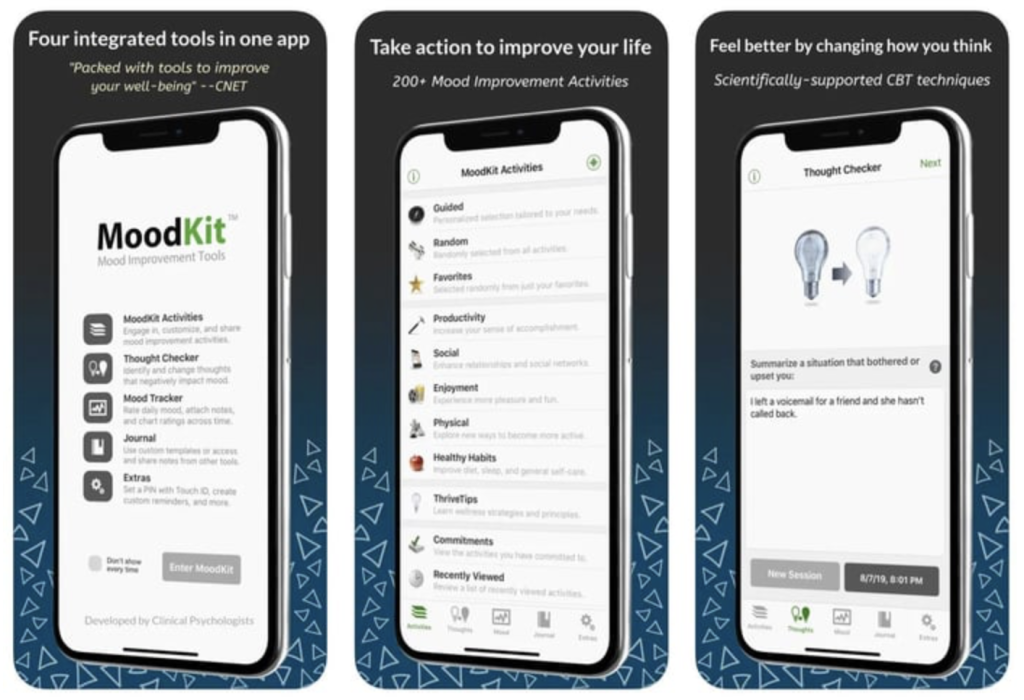
Sleep and Relaxation
These solutions focus on improving sleep quality, promoting relaxation and reducing sleep-related issues. To establish healthy routines and improve sleep patterns, people can get access to:
- soothing sounds
- bedtime stories
- sleep tracking tools
- sleep hygiene tips.
For instance, Calm offers an extensive library of sleep sounds, meditations, sleep stories. Such functionality makes it ideal for promoting relaxation and aiding in falling asleep.

Mindfulness and Meditation
These solutions empower people to practice mindfulness in their daily lives. To cultivate awareness, reduce anxiety, and enhance focus, applications usually offer:
- guided meditation sessions
- mindfulness practices
- stress-reduction techniques.
For instance, with its vast library of guided meditations and mindfulness exercises, Headspace is renowned for its user-friendly interface and effective techniques in promoting mental well-being.
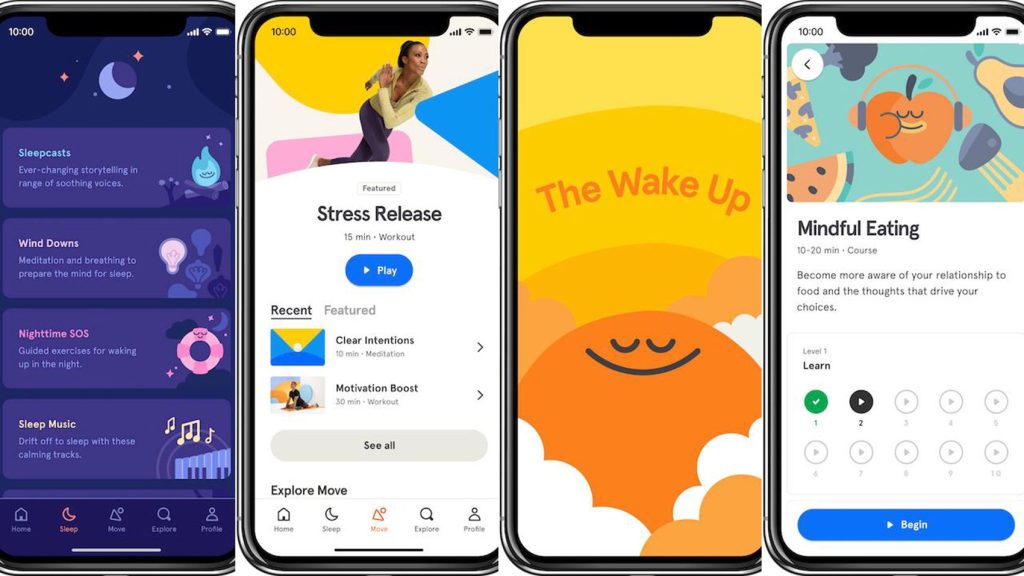
Substance Abuse and Addiction Recovery
Apps targeting addiction recovery provide support, accountability, and resources for those navigating recovery journeys. These applications may include:
- sober trackers
- coping mechanisms for cravings
- relapse prevention strategies
- access to peer support groups or professional assistance.
A good example is Sober Grid. It provides a supportive community and tools to aid in maintaining sobriety and navigating the journey to recovery.
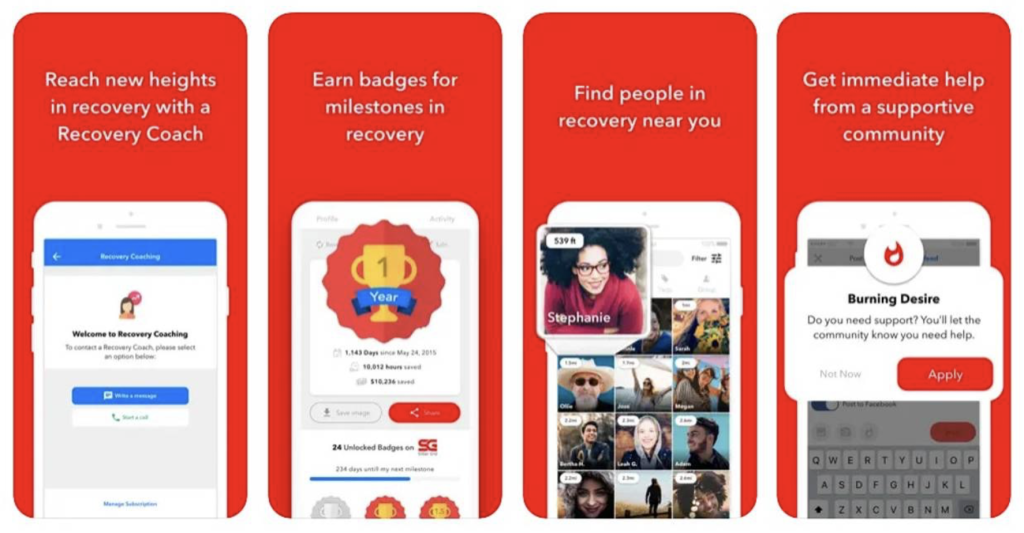
Eating Disorder Management
Such tools offer comprehensive support for those struggling with disordered eating behaviors. Such solutions commonly include:
- meal tracking features
- nutritional guidance
- body positivity exercises
- connections to eating disorder specialists.
For instance, Recovery Record offers tools for tracking meals, emotions, and behaviors, along with access to communities and resources to aid in promoting a healthy relationship with food.

How to Create a Mental Health App
If you are planning to create a mental health app, you should eventually achieve a blend of technological innovation, empathetic design, and evidence-based content. Here’s a comprehensive guide on how to develop a mental health app that makes a positive impact:
Understanding User Needs and Pain Points
Conduct thorough research to understand the target audience’s needs and challenges. Consider the specific demographics, psychological concerns, and preferences of potential users. Engage with industry specialists and conduct surveys to ensure your app addresses real issues. Proper market research will also help you define essential functionality.
Designing a User-Centric Interface
It is vital to create interface that promotes both ease of use and accessibility. Help people feel comfortable and engaged while using your product. Utilize calming colors, clear navigation, and simple language. Incorporate interactive elements, engaging visuals, and customizable settings to enhance the UX.
Building a Robust Backend Infrastructure
Invest in a secure and scalable backend system for seamless performance. Implement cloud storage solutions, reliable servers, and regular backups to safeguard data and maintain operational efficiency. Prioritize reliability, speed, and responsiveness.
Testing and Iteration for Continuous Improvement
Conduct extensive testing across different devices and operating systems to address usability issues. Gather feedback from beta testers, therapists, and end-users to refine the functionality. Embrace a culture of continuous improvement through regular updates/enhancements based on insights.
Promoting the Application and Ensuring Ethical Use
Develop a robust marketing strategy to raise awareness about your solution. Collaborate with mental health advocacy organizations, influencers, and industry professionals to promote your product responsibly. Prioritize ethical use of data, transparent communication, and adherence to industry guidelines to build trust and credibility within the community.
Tech Stack for Mental Health Apps
A well-structured tech stack ensures seamless functionality and integration of essential features. Let’s delve into the tech stack components typically used in developing such applications:

Key Features to Include in Your Mental Health App
Signing Up
Make the sign-up process simple and straightforward, requiring minimal info to get started. Consider offering social media login options for convenience.
Creating a Profile
Allow users to create a personalized profile where they can input relevant details. Include age, gender, goals, and other basic parameters.
Goal Setting and Progress Tracking
Let users set achievable goals, whether it’s improving sleep quality, or practicing self-care. Progress tracking features provide motivation and a sense of accomplishment.
Symptom Checkers and Self-Assessment Tools
Incorporate self-assessment tools so individuals could evaluate their symptoms. Allow them to receive personalized feedback and access relevant content based on the results.
Mindfulness and Meditation Exercises
Integrate meditation sessions for reducing stress, improving focus, cultivating a sense of calm. Offer different experience levels and preferences.
Helplines
Individuals may encounter distressing situations or require immediate assistance. For those experiencing crises, include crisis support resources:
- helplines
- suicide prevention hotlines
- emergency contacts.
Ensure easy access to these critical services within the application.
Psychoeducation and Information Resources
Offer useful content on coping strategies, treatment options, and general well-being tips.
Community Support and Peer Groups
Building a supportive online community helps combat feelings of isolation. Facilitate connections among users by integrating community forums. Here, you can integrate peer support groups or virtual group therapy sessions.
Personalized Recommendations and Insights
Offer personalized recommendations and resources based on user interactions and goals. Tailoring the experience enhances engagement and relevance for each individual.
Reminders and Notifications
Enable users to set reminders for medication intake, self-care activities, therapy appointments, meditations. Such push notifications help people stay on track with their routine.
Professional Teletherapy Services
Consider partnering with licensed therapists to offer teletherapy sessions within the app. It is a good option to complement self-help tools and encourage individuals to seek professional help when needed.
Main Monetization Strategies for Mental Health App Development
A well-balanced monetization approach will ensure your app’s long-term success. By implementing the right strategies here, you can create sustainable revenue streams while providing valuable psychological help to those who need it most. When choosing a strategy, consider your TA’s preferences, your value proposition, ethical considerations.
Freemium
The model offers basic functionality for free while charging for premium features or content. You can provide essential functionalities such as mood tracking and journaling for free, with advanced features like personalized therapy sessions or in-depth psychoeducational content available through in-app purchases or subscriptions.
Subscription-Based
Implementing this model offers access to the full range of features for a recurring fee. You can offer different subscription tiers with varying levels of access, such as monthly, quarterly, or annual subscriptions. Regular updates and exclusive content incentivize people to subscribe to unlock the product’s complete potential.
In-App Purchases
In-app purchases let users unlock additional resources, tools, or features. For example, they could purchase packs of meditation sessions, premium self-help courses, or ad-free experiences.
Ad-Based Monetization
Integrating advertising within the app generates revenue through partnerships with relevant advertisers. Displaying targeted ads based on user preferences and interactions can be a non-intrusive way to monetize the app. Balance ad placement so it does not compromise the user experience or detract from the app’s primary purpose.
Partnerships and Collaborations
Collaborating with industry professionals, wellness brands, or institutions also opens up monetization opportunities. For instance, you can offer co-branded services, joint events, or sponsored content. Partnering with reputable organizations also adds credibility and value to your app’s offerings.
Top Concerns Mental Wellness Applications Need to Handle
No doubt, mental health apps offer a range of benefits. However, they also face several challenges that need to be addressed to create a safe digital environment:
Data Privacy and Security
Such apps usually collect sensitive information related to mental health. Thus, robust data privacy measures are crucial. To safeguard user confidentiality and trust, we recommend implementing:
- encryption protocols
- secure storage practices
- transparent data handling policies.
Ethical Use of Data
Respecting user consent and privacy preferences is essential in maintaining ethical standards. Thus, clearly communicate how user data will be utilized i.e. it is not exploited for purposes other than improving the functionality or providing personalized support.
Clinical Validation and Expert Involvement
To enhance the app’s credibility and effectiveness, consider involving mental health professionals and clinicians in the development process. Collaborating with experts will help you ensure that the functionality is right and the content is evidence-based/clinically validated.
Cultural Sensitivity and Inclusivity
These are vital considerations for mental wellness apps, given the diverse backgrounds and identities of people seeking support. Consider adding inclusive content, language options, and culturally relevant resources. It will ensure everyone feels represented and supported in their journey.
The bottom line
The mental health app market is undeniably one of the sectors that keeps supporting our society, plus, still has a great investment potential. Thus, if you already know how to create a mental health app, it’s also important to strike a balance between incorporating popular features and ensuring your solution remains accessible, simple and really helpful.
So, if you have an idea on how to assist individuals dealing with psychological issues, now is the perfect time to put it into action. Get in touch with Ein-des-ein to build a unique product that could be a game changer for the world.
FAQ
-
What is a mental health app?
- It is a mobile solution aimed to improve psychological well-being through various features.
-
How long does it take to build an average mental health tracker app?
-
The development timeline varies depending on the complexity, design requirements, QA phases etc.
On average, building a functional basic option takes around 4 to 9 months from concept to launch. However, more advanced ones require longer development cycles. -
What are the essential features of a mental health mobile app?
-
Basic functionality typically consists of:
journaling capabilities for self-reflection
meditation exercises
interactive options for goal setting
ability to find relevant therapists etc. -
Does Ein-des-ein have experience in developing other apps for the healthcare industry?
-
We excel in creating various products tailored specifically for the healthcare industry. For example, we build:
1. Electronic Health Records (EHR) Systems. We help streamline patient data management, and improve clinical decision-making.
2. Telemedicine Platforms. Here, we help facilitate virtual consultations and seamless communication between doctors and patients.
3. Medication Management Software. Medical facilities can optimize prescription workflows, and improve medication adherence.
4. Radiology Imaging Platforms. Our software assists radiologists in interpreting images and generating reports for accurate diagnosis.
5. Advanced surgical Planning Tools. Our technologies support surgeons in preoperative planning, simulation, and optimization of surgical procedures.
6. Data Analytics and Reporting Tools. Your facility can leverage healthcare data to identify trends and drive evidence-based decision-making for enhanced operational performance and patient outcomes.
…and other options. Read more about our services here! -
What modern technologies can I utilize for my mental health application?
-
You can leverage a variety of modern technologies to enhance your application:
1) AI/ML and predictive analytics help provide targeted interventions;
2) Chatbots offer immediate guidance and provide requested resources;
3) Blockchain technology offers secure storage of sensitive data, ensuring privacy and confidentiality. -
Have you ever implemented AI technology in healthcare applications?
-
Sure, as EDE constantly works on AI-based software. For instance, we embarked on a groundbreaking project to develop an AI-based posture analysis app. The journey began with intensive research into necessary machine learning algorithms. Then, our team of expert developers meticulously crafted the application’s architecture. The first feature we implemented was the photo uploading. Users could easily submit their images for further analysis. Once the photos were uploaded, AI algorithms analyzed the posture with remarkable accuracy. The person got insightful feedback on their posture. Based on the result, a set of recommended excercises was offered. A progress tracking tool allowed people to monitor improvements over time.
Continuous testing and iteration were key parts of our development process. As a result of our efforts, this AI-based posture analysis instrument gained widespread acclaim for its effectiveness and user-centric design. Users reported significant improvements in their posture.